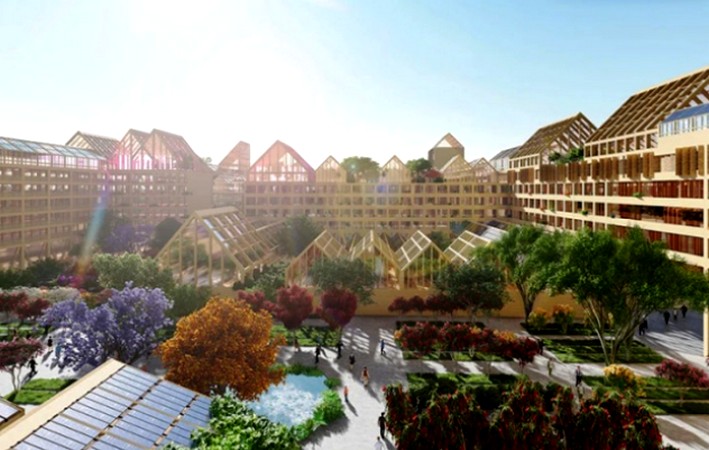New Paradigm: Why Wood Leads the Transition Towards a More Sustainable Industry?
World Construction Day invites reflection on the present and future of one of the most decisive activities for human development. Today, however, this reflection takes on unprecedented urgency: The construction sector is responsible for nearly 40% of global carbon emissions, and the way we build our homes, schools, hospitals, and cities will largely determine the success or failure of the fight against climate change.
In this context, wood has moved from being a marginal alternative to becoming the heart of a profound transformation. It's not just a technical or aesthetic change, but a new construction paradigm.
The recent report by the United Nations Environment Programme (UNEP) and Yale University, titled "Building Materials and The Climate: Constructing a New Future," warns that every five days, constructions equivalent to the size of Paris are built worldwide.
This pace of urbanization, unsustainable under traditional models based on cement and steel, demands the adoption of bio-based materials—like wood—capable of reducing emissions by up to 40% by 2050.
Countries across all continents are moving towards policies that promote energy efficiency, material decarbonization, the reuse of existing buildings, and the incorporation of modular and prefabricated technologies.
In Argentina, this change is also beginning to be felt. The timber industry, supported by FAIMA and its 28 associated chambers across the country, is driving an agenda that combines sustainability, innovation, and competitiveness.
The goal is significant: to position wood as a strategic axis for national construction development, aligning housing demand, responsible use of forest resources, and the creation of quality employment throughout the territory.
Global Transformation of the Sector
The transformation the construction sector is undergoing worldwide today is unprecedented. In just a decade, the concept of a "sustainable building" has gone from a niche aspiration to a technical and ethical standard that redefines public policies, regulations, and value chains.
Furthermore, the change is accelerating, driven by commitments made under the Paris Agreement and by international reports that place the built environment sector at the center of the global climate agenda.
According to the United Nations Environment Programme (UNEP), the building and construction sector currently accounts for 37% of global greenhouse gas emissions and consumes more than one-third of the planet's total energy.
Faced with this scenario, international bodies propose an urgent shift: abandoning the linear model based on energy-intensive materials—cement, steel, and aluminum—and moving towards a circular economy that prioritizes the use of renewable, recyclable, and low-carbon footprint materials, led by wood.
The report "Building Materials and The Climate: Constructing a New Future," prepared by UNEP together with Yale University, proposes a three-pronged strategy—Avoid, Shift, Improve—to decarbonize the sector.
- Avoid: reduce the need for new construction by reusing existing buildings and circular design, which can lower emissions by 50 to 75%.
- Shift: replace conventional materials with bio-based alternatives like wood, bamboo, or biomass, which could generate savings of up to 40% in cumulative emissions by 2050.
- Improve: optimize the production processes of steel, cement, and glass that cannot be replaced, through capture technologies and energy efficiency.
The result of this transition is already visible. In Europe, projects like Mjøstårnet in Norway (18 stories) or Sara Kulturhus in Sweden (20 stories) demonstrate that wood can compete in height, strength, and durability with traditional materials, also offering superior thermal, acoustic, and aesthetic benefits.
In the United States, Japan, Canada, and Australia, industrialized and modular wood construction is advancing at a steady pace, supported by public policies, fiscal incentives, and regulations for high-rise construction.
The Argentine Evolution: A Cultural and Industrial Change
Over the last decade, Argentina has begun to follow a path of transformation similar to that of the most advanced countries in sustainable construction. Although structural challenges remain—such as regulatory updates, technical training, and the availability of green financing—the cultural shift is undeniable.
"The wood construction market in Argentina is in a process of sustained growth, despite the difficulties encountered along the way," explains Daniel Vier.
"Compared to 10 or 20 years ago, a significant change in demand and supply is observed: wood has moved from being a decorative or rural material to positioning itself as a modern, efficient, and sustainable option for projects of any scale."
The reasons are multiple. On one hand, growing environmental awareness and the international commitments made by the country are driving a deep review of construction practices.
On the other hand, the need for more efficient, faster, and accessible housing promotes the adoption of construction systems like Platform Frame and SIPs (Structural Insulated Panels), which allow for cleaner, more predictable execution with less waste.
In regions like Mesopotamia and Patagonia, the wood value chain generates thousands of direct and indirect jobs, invigorating regional economies and strengthening the supply of certified national products.
From FAIMA, the vision is clear: wood is not just a construction material, but a tool for industrial and environmental development. Integrating sustainable forestry production with efficient construction opens a strategic opportunity for the country. It allows for reducing emissions, substituting imports, generating quality employment, and expanding the housing supply, in line with global decarbonization goals.
The Challenges Ahead: Policy, Technology, and Training
The path towards truly sustainable construction does not depend solely on material choice. It also requires an ecosystem of policies, innovation, and knowledge capable of sustaining that change over time. In Argentina, this process is already underway, although it still faces barriers that must be resolved comprehensively and in a coordinated manner.
One of the main challenges is regulatory updating. Wood as a structural material still faces gaps or limitations in the building codes of some jurisdictions, which restricts its widespread use.
Another key point is professional training. Architects, engineers, builders, and technicians need updated tools to design, calculate, and execute wood projects safely and efficiently. From FAIMA, together with its associated chambers, a coordinated effort is being promoted with universities, technical institutes, and public bodies to strengthen training and knowledge transfer at all levels.
Technological innovation will also be decisive. The digitalization of processes, parametric design, the use of BIM (Building Information Modeling), and the industrialization of components in factories are trends that are already transforming the way we build.
Finally, green financing and fiscal incentives will play a central role. Globally, the countries that have advanced the most in sustainable construction have done so by combining public policies with frameworks that stimulate the private sector. The adoption of green credits, carbon footprint certification, and environmental standards in public procurement are tools that Argentina can and must enhance.
Source:Noticias Agropecuarias
















